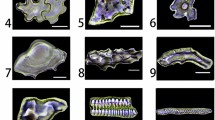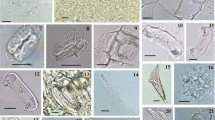Abstract
Phytoliths were extracted from 14 woody plants collected on the northern slope of the Changbai Mountain, including 10 broad-leaved species and 4 conifers. A total of 14 morphotypes of phytoliths were identified, including 3 types first examined in this study. Phytoliths in broad-leaved species were mostly silicified epidermal cells, cell walls, and vascular tissues; phytoliths in conifers were mainly silicified epidermal cells, cell walls, hypodermal cells, and parenchyma cells. Phytoliths produced by broad-leaved species in this region were usually not well silicified, and were fragile, whereas those produced by conifers were better silicified; this might be because of the different lengths of the growth periods. Phytoliths were found have potential in studies of fluctuations of the tree line in this region, and this study also provided a reference for further study of phytoliths in this region and the regional contrast of phytolith assemblages.




Similar content being viewed by others
References
Carnelli AL, Madella M, Theurillat J-P (2001) Biogenic silica production in selected Alpine plant species and plant communities. Ann Bot 87(4):425–434
Carnelli AL, Theurillat J-P, Madella M (2004) Phytolith types and type-frequencies in subalpine-alpine plant species of the European Alps. Rev Palaeobot Palynol 129(1–2):39–65
Carter JA (2002) Phytolith analysis and paleoenvironmental reconstruction from Lake Poukawa Core, Hawkes Bay, New Zealand. Glob Planet Chang 33(3–4):257–267
Carter JA (2009) Atmospheric carbon isotope signatures in Phytolith-occluded carbon. Quant Int 193:20–29
Chu GQ, Sun Q, Gu ZY et al (2009) Dust records from varved lacustrine sediments of two neighboring lakes in northeastern China over the last 1400 years. Quat Int 194(1–2):108–118
Fraysse F, Pokrovsky OS, Schott J et al (2009) Surface chemistry and reactivity of plant phytoliths in aqueous solutions. Chem Geol 258:197–206
Ge Y, Jie DM, Guo JX et al (2010) Response of phytoliths in Leymus chinensis to the simulation of elevated global CO2 concentrations in Songnen Grassland, China. Chin Sci Bull 55:3703–3708. doi:10.1007/s11434-010-4123-2
Geis JW (1973) Biogenic silica in selected species of deciduous Angiosperms. Soil Sci 116(2):113–130
Gu YS, Pearsall DM, Xie SC et al (2008) Vegetation and fire history of a Chinese site in southern tropical Xishuangbanna derived from phytolith and charcoal records from Holocene sediments. J Biogeogr 35(2):325–341
Hong B, Hong YT, Lin QH et al (2010) Anti-phase oscillation of Asian monsoons during the younger dryas period: evidence from peat cellulose [delta]13C of Hani, Northeast China. Palaeogeogr Palaeoclim Palaeoecol 297(1):214–222
Jiang W, Leroy SAG, Ogle N et al (2008) Natural and anthropogenic forest fires recorded in the Holocene pollen record from a Jinchuan peat bog, northeastern China. Palaeogeogr Palaeoclim Palaeoecol 261(1–2):47–57
Jie DM, Liu ZY, Shi LX et al (2010) Characteristics of phytoliths in Leymus chinensis from different habitats on the Songnen Plain in Northeast China and their environmental implications. Sci Chin Earth Sci 53(7):984–992. doi:10.1007/s11430-010-0047-6
Jie DM, Liu HM, Ge Y et al. (2011) Phytoliths analysis: morphological characteristics of Peatland plant species in Changbai Mountains. Quant Sci. doi:10.3969/j.issn.1001-7410.2011.01.0
Kealhofer L, Piperno DR (1998) Opal phytoliths in Southeast Asian flora. Smithsonian Institution Press, Washington
Klein RL, Geis JW (1978) Biogenic silica in the Pinaceae. Soil Sci 126(3):145–156
Kondo R, Childs C, Atkinson I (1994) Opal phytoliths of New Zealand. Manaaki Whenua Press, Lincoln
Kondo R, Sumda T (1978) Opal phytoliths in tree leaves (part 1): Opal phytoliths in gymnosperm and monocotyledonous angiosperm tree. Soil Sci Plant Nutr 49(2):138–144 (in Japanese)
Li JD, Wu BH, Sheng LX (2001) Vegetation of Jilin, 1st edn. Jilin Science and Technology Press, Jilin
Lu HY, Yang XY, Ye ML et al (2005) Culinary archaeology: millet noodles in late Neolithic China. Nature 437(7061):967–968
Lu HY, Wu NQ, Yang XD et al (2006) Phytoliths as quantitative indicators for the reconstruction of past environmental conditions in China I: phytolith-based transfer function. Quat Sci Rev 25:945–959
Lu HY, Wu NQ, Liu KB, Jiang H, Liu TS (2007) Phytoliths as quantitative indicators for the reconstruction of past environmental conditions in China II: palaeoenvironmental reconstruction in the Loess Plateau. Quat Sci Rev 26(5–6):759–772
Madella M, Alexandre A, Ball T (2005) International code of phytolith nomenclature 1.0. Ann Bot 96:253–260
Makohonienko M, Kitagawa H, Naruse T, Nasu H, Momohara A, Okuno M, Fujiki T, Liu X, Yasuda Y, Yin H (2004) Late-Holocene natural and anthropogenic vegetation changes in the Dongbei Pingyuan (Manchurian Plain), northeastern China. Quat Int 123–125:71–88
Makohonienko M, Kitagawa H, Fujiki T et al (2008) Late Holocene vegetation changes and human impact in the Changbai Mountains area, Northeast China. Quat Int 184(1):94–108
Mercader J, Bennett T, Esselmont C et al (2009) Phytoliths in woody plants from the Miombo woodlands of Mozambique. Ann Bot 104(1):91–113
Morris LR, Baker FA, Morris C et al (2009) Phytolith types and type-frequencies in native and introduced species of the sagebrush steppe and pinyon-juniper woodlands of the Great Basin, USA. Rev Palaeobot Palynol 157(3–4):339–357
Piperno DR (1988) Phytolith analysis: an archaeological and geological perspective. Academic Press, San Diego
Piperno DR (2006) Phytoliths: a comprehensive guide for archaeologists and paleoecologists. AltaMira Press, New York
Qiao ZH, Jie DM, Liu HM et al (2010) Morphological characteristics and environmental implications of phytoliths in topsoils from different vegetation zones on northern slope of Changbai Mountains, China. Chin Geogr Sci 20(6):506–512
Rovner I (1971) Potential of opal phytoliths for use in paleoecological reconstruction. Quat Res 1(3):343–359
Wang YJ, Lu HY (1993) Phytolith study and its application. China Ocean Press, Beijing
Zhang XR, Hu K, Jie DM et al (2005) Environment indication of phytolith in peat deposit: a case in the peat section of Dunhua, Jilin Province. J Jilin Univ (Earth Sci Edit) 35(6):694–698
Acknowledgments
We are very thankful to Song Chuantao for his identification of plants and Professor Lu Jinfu for his valuable suggestions on this manuscript, and the constructive comments from the reviewer. This study was supported by the National Nature Science Foundation of China (No. 40971116).
Author information
Authors and Affiliations
Corresponding author
Rights and permissions
About this article
Cite this article
Ge, Y., Jie, D.M., Sun, Y.L. et al. Phytoliths in woody plants from the northern slope of the Changbai Mountain (Northeast China), and their implication. Plant Syst Evol 292, 55–62 (2011). https://doi.org/10.1007/s00606-010-0406-y
Received:
Accepted:
Published:
Issue Date:
DOI: https://doi.org/10.1007/s00606-010-0406-y




